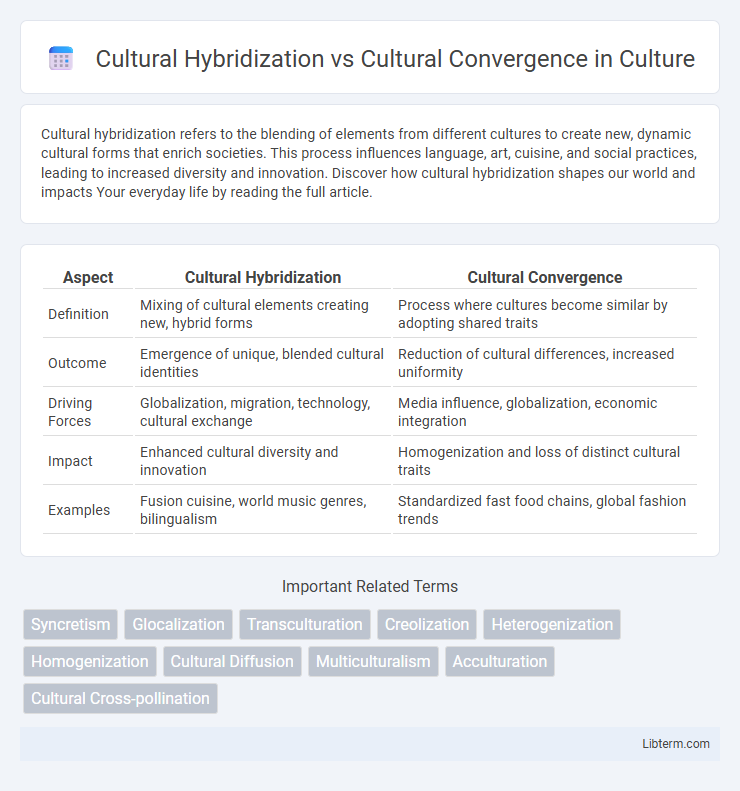Cultural hybridization refers to the blending of elements from different cultures to create new, dynamic cultural forms that enrich societies. This process influences language, art, cuisine, and social practices, leading to increased diversity and innovation. Discover how cultural hybridization shapes our world and impacts Your everyday life by reading the full article.
Table of Comparison
| Aspect | Cultural Hybridization | Cultural Convergence |
|---|---|---|
| Definition | Mixing of cultural elements creating new, hybrid forms | Process where cultures become similar by adopting shared traits |
| Outcome | Emergence of unique, blended cultural identities | Reduction of cultural differences, increased uniformity |
| Driving Forces | Globalization, migration, technology, cultural exchange | Media influence, globalization, economic integration |
| Impact | Enhanced cultural diversity and innovation | Homogenization and loss of distinct cultural traits |
| Examples | Fusion cuisine, world music genres, bilingualism | Standardized fast food chains, global fashion trends |
Understanding Cultural Hybridization
Cultural hybridization refers to the process where distinct cultural elements blend to create new, unique cultural expressions, reflecting globalization's impact on local traditions. This phenomenon contrasts with cultural convergence, which implies cultures becoming more similar over time mainly due to shared technologies and media. Understanding cultural hybridization highlights the dynamic and reciprocal exchange that fosters innovation and cultural diversity rather than uniformity.
Defining Cultural Convergence
Cultural convergence refers to the process where distinct cultures become more alike due to increased interaction, communication, and exchange of ideas, often driven by globalization and technological advancements. It results in shared cultural traits, values, and practices, leading to homogenization across societies. This phenomenon contrasts with cultural hybridization, which emphasizes blending and creating new, diverse cultural forms rather than uniformity.
Historical Contexts of Cultural Exchange
Cultural hybridization emerged from historical contexts such as trade routes, colonization, and migration, blending distinct traditions into new, syncretic forms that reflect diverse influences. Cultural convergence refers to the process where global interactions lead to the uniformity of cultural expressions, often driven by technological advancements and mass media since the 20th century. Historical examples include the Silk Road fostering hybrid art and religion, contrasted with the recent globalization trend promoting convergence through popular culture and multinational corporations.
Key Differences Between Hybridization and Convergence
Cultural hybridization involves the blending of distinct cultural elements to create new, unique cultural forms, emphasizing diversity and innovation within global interactions. Cultural convergence refers to the process by which different cultures become more similar due to shared practices, values, and technologies, often resulting in homogenization. The key difference lies in hybridization fostering cultural diversity through fusion, while convergence drives cultures toward uniformity and assimilation.
Drivers of Cultural Hybridization
Cultural hybridization is driven by globalization, technological advancements, and increased intercultural communication, enabling the blending of diverse cultural elements into new, hybrid forms. Migration, digital media, and the global flow of goods and ideas facilitate the fusion of customs, languages, and traditions across societies. These drivers contrast with cultural convergence, which emphasizes homogenization towards a dominant culture rather than creating hybrid cultural identities.
Mechanisms Facilitating Cultural Convergence
Mechanisms facilitating cultural convergence include globalization, technology, and mass media, which promote the exchange and blending of cultural elements across societies. Global communication networks enable rapid dissemination of ideas, values, and practices, leading to shared norms and behaviors. These processes reduce cultural differences, fostering homogeneity while influencing economic, social, and political integration worldwide.
Real-World Examples of Hybrid Cultures
Cultural hybridization manifests in societies like Singapore, where diverse ethnic groups blend traditional practices, languages, and cuisines to create a unique cultural identity. This contrasts with cultural convergence seen in global cities such as New York, where dominant cultural traits from powerful economies lead to homogenized lifestyles and entertainment. Real-world examples of hybrid cultures showcase how intercultural exchange fosters innovation without erasing local distinctiveness.
Globalization’s Impact on Cultural Interactions
Globalization accelerates cultural hybridization by blending distinct traditions, languages, and practices into new, dynamic forms that reflect interconnected societies. In contrast, cultural convergence emphasizes the increasing similarity of cultures worldwide, often driven by dominant media, technology, and multinational corporations standardizing cultural expressions. Both processes highlight globalization's profound ability to reshape cultural identities, fostering both diversity and uniformity in global cultural interactions.
Challenges and Critiques of Both Concepts
Cultural hybridization faces challenges such as the risk of cultural appropriation, power imbalances, and the dilution of indigenous identities, raising concerns about authentic representation. Cultural convergence is critiqued for potentially leading to cultural homogenization, loss of diversity, and the dominance of global Western norms over local traditions. Both concepts struggle with balancing globalization's influence while preserving cultural uniqueness and resisting cultural imperialism.
Future Trends: Hybridization vs Convergence
Future trends in cultural hybridization emphasize the blending of diverse cultural elements to create new, multifaceted identities, driven by globalization and digital communication. Cultural convergence trends focus on the increasing similarity of cultures through shared technologies, global media, and economic integration, leading to homogenization in consumption patterns and communication styles. The ongoing dynamic between hybridization and convergence will shape global cultural landscapes, balancing between preserving unique traditions and fostering interconnectedness.
Cultural Hybridization Infographic

 libterm.com
libterm.com